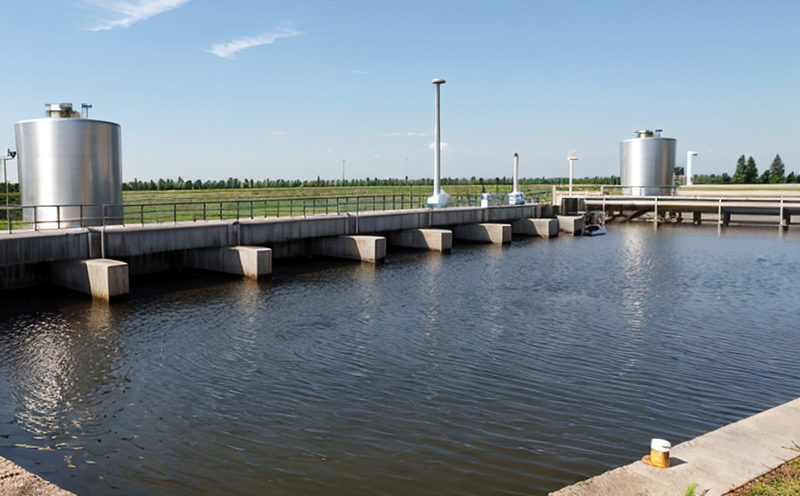EN ISO 16221 Cryptosporidium Detection Testing in Surface Waters
The detection of Cryptosporidium, a protozoan parasite, is critical for the safety and quality assurance of surface water supplies. This service focuses on the implementation of the EN ISO 16221 standard which provides methodologies for the detection of this pathogen in drinking water sources.
Cryptosporidium is a significant health concern, especially when present in surface waters used for potable purposes. The parasite can cause severe gastrointestinal illness and has a high resistance to chlorine disinfection processes commonly employed by water treatment facilities. As such, rigorous testing protocols are essential to ensure the safety of these supplies.
The EN ISO 16221 standard outlines specific procedures for the concentration, enumeration, and identification of Cryptosporidium oocysts in water samples. It specifies various methodologies including filtration techniques, immunofluorescence staining, and microscopy to accurately detect these microorganisms.
The testing process involves several key steps. Initially, surface water samples are collected from the source using sterile equipment to prevent contamination. After collection, the samples undergo a series of filtration processes designed to concentrate the Cryptosporidium oocysts into smaller volumes for more efficient analysis.
Following concentration, the filtered samples are examined under a microscope after undergoing immunofluorescence staining techniques. This method enhances visibility and accuracy in detecting even minute Cryptosporidium oocysts. Once detected, these pathogens can be further identified using advanced molecular diagnostic tools such as PCR (Polymerase Chain Reaction) to confirm the presence of specific species.
This service ensures compliance with regulatory standards such as EN ISO 16221 and supports water utility companies in meeting stringent health and safety requirements. By adhering to these protocols, we contribute to maintaining public health by eliminating potential risks associated with Cryptosporidium contamination.
The importance of this service cannot be overstated given the increasing demand for safe drinking water worldwide. Ensuring that water supplies are free from harmful pathogens like Cryptosporidium is crucial in preventing outbreaks and maintaining public confidence in these essential services.
- Methodological Precision: The EN ISO 16221 standard ensures consistent and accurate detection of Cryptosporidium oocysts, reducing the risk of false positives or negatives.
- Rigorous Compliance: Adherence to this international standard guarantees that water suppliers meet regulatory requirements set by health authorities.
- Public Health Protection: By eliminating Cryptosporidium, we contribute significantly to public health and safety.
- Efficient Resource Utilization: This testing process optimizes the use of water resources by identifying contaminated sources early, allowing for targeted interventions.
In conclusion, our service plays a pivotal role in safeguarding surface water supplies against Cryptosporidium. By utilizing the EN ISO 16221 standard and state-of-the-art testing methodologies, we provide reliable data that informs critical decisions affecting public health.
Why It Matters
The detection of Cryptosporidium in surface waters is crucial for several reasons. Firstly, it directly impacts public health by preventing the spread of this parasitic infection, which can cause severe gastrointestinal symptoms such as diarrhea, dehydration, and vomiting.
Secondly, compliance with international standards like EN ISO 16221 ensures that water utilities meet stringent regulatory requirements set forth by health authorities. This not only protects public health but also fosters trust in the reliability of these services.
Moreover, detecting Cryptosporidium early allows for targeted interventions and resource optimization. By identifying contaminated sources promptly, water treatment facilities can implement necessary measures to prevent further contamination, thereby saving valuable resources and ensuring efficient use of infrastructure.
In the context of global health initiatives aimed at improving water quality and sanitation, the detection of Cryptosporidium is a critical component. Ensuring that surface waters are free from this pathogen contributes significantly to meeting these ambitious goals and enhancing overall public health.
The importance of this service extends beyond immediate health impacts; it also plays a role in long-term environmental sustainability efforts. By detecting and addressing Cryptosporidium contamination, we contribute to the preservation of natural water resources and support sustainable development practices.
In summary, the detection of Cryptosporidium is essential for safeguarding public health, ensuring compliance with regulatory standards, optimizing resource use, and supporting global sustainability initiatives. This service is not just a technical requirement but also a commitment to maintaining the highest standards in water quality.
Environmental and Sustainability Contributions
The detection of Cryptosporidium through EN ISO 16221 contributes significantly to environmental sustainability by ensuring that surface waters are free from harmful pathogens. This service supports sustainable practices in several ways:
Resource Conservation: By identifying and addressing contaminated sources early, water treatment facilities can optimize their processes, reducing the need for additional chemicals or energy-intensive treatments.
Water Quality Improvement: Ensuring that surface waters are free from Cryptosporidium helps maintain high water quality standards, which is essential for both human health and aquatic ecosystems.
Eco-friendly Practices: This service aligns with broader sustainability goals by promoting eco-friendly water management practices. It supports the reduction of environmental impact through efficient resource use and minimized contamination risks.
Sustainable Development Goals (SDGs): By contributing to the detection and elimination of Cryptosporidium, we support multiple SDGs, particularly those related to health, water quality, and sustainable development. This service is a key component in achieving these global objectives.
The environmental and sustainability contributions of this testing service are far-reaching and have long-term benefits. By ensuring that surface waters are free from Cryptosporidium, we not only protect public health but also contribute to the preservation of natural resources and support sustainable development practices.





